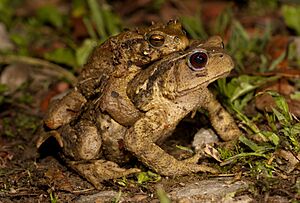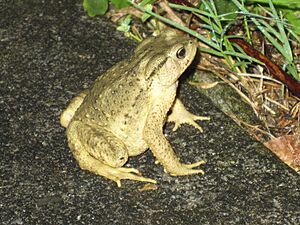Bufo bankorensis facts for kids
Quick facts for kids Bufo bankorensis |
|
|---|---|
 |
|
| Conservation status | |
| Scientific classification |
The Central Formosa toad, also known as the Bankor toad, is a type of toad. Its scientific name is Bufo bankorensis. This special toad lives only in Taiwan. You can find it high up in the mountains, sometimes as high as 3,000 meters (about 9,800 feet) above sea level! Scientists have studied this toad carefully. They now agree it is its own unique species.
Contents
What Does the Central Formosa Toad Look Like?
The Central Formosa toad is a very large toad. It can grow up to 15 centimeters (about 6 inches) long. Some can even reach 20 centimeters (about 8 inches) from their nose to their rear end! Female toads are usually bigger than males.
This toad has a short nose. Its skin is rough and bumpy. It has many small, pointed bumps called tubercles. The toad's skin color is usually light brown. It often has cool markings in orange, yellow, or black. Behind its eyes, it has special kidney-shaped glands. These are called parotoid glands. They help protect the toad.
Where Do These Toads Live?
Central Formosa toads live in many different places. They can be found in broadleaf forests. They also live in mixed forests and even in orchards. You might see them in cultivated fields too. These toads like to hunt for insects. They often look for food under street lights. This happens especially on rainy nights.
How Do They Have Babies?
These toads can lay their eggs in different water spots. They use both streams and pools for breeding. Some toads that live in cooler areas breed all year long. Other toads, living in warmer places, breed during the cooler months. This usually happens from September to March.
Is the Central Formosa Toad Safe?
The Central Formosa toad is a common species. However, it still faces some challenges. One big problem is habitat loss. This means their homes are disappearing. People sometimes collect these toads for food. They are also used in traditional medicine. Scientists and conservation groups work to protect these amazing toads.



